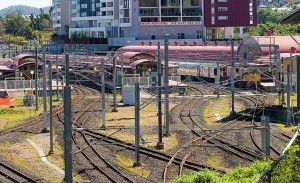Cities could be stuck with ‘aesthetic’ impacts of High Speed Rail
by CalWatchdog Staff | May 30, 2013 11:56 am
 [1]May 30, 2013
[1]May 30, 2013
By Wayne Lusvardi
Like a train horn, controversy[2] is blaring over efforts to reform the California Environmental Quality Act. One issue is whether the state’s environmental law is anti-business — or, conversely, does not go far enough to fight global warming/climate change.
But the real political struggle in the California Legislature over CEQA reform under Senate Bill 731[3] is over the “aesthetic” impacts of transit villages at proposed stations for the trains of the California High-Speed Rail Authority[4]. The bill is by Senate President Pro Tem Darrell Steinberg, D-Sacramento, and state Sen. Jerry Hill, D-San Mateo. It passed the full Senate on May 29, and now is being considered in the Assembly.
Aesthetic impact reductions not funded
Under SB 731, those who live in or near “transit villages” would not have the right to sue under CEQA to reduce impacts from greater visual blight, traffic, smog or noise caused by transit village housing projects, associated retail development or “employment centers.”
CEQA reform means that local communities with proposed train stations would have to pick up the tab for mitigating any visually unappealing or nuisance impacts from proposed transit villages. Local communities would be prohibited from using funds from state-issued bonds to reduce housing nuisance impacts at train stations.
Here’s the language of SB 731[5]:
“(c) (1) Aesthetic impacts of a residential, mixed use residential, or employment center project within a priority transit area shall not be considered significant impacts on the environment.”
Cities that would be stuck with costs to mitigate any negative impacts[6] from transit villages would be: San Francisco, Millbrae, San Jose, Gilroy, Sacramento, Stockton, Modesto, Merced, Fresno, Bakersfield, Palmdale, San Fernando, Burbank-Glendale, Norwalk, Fullerton, City of Industry, Ontario, Anaheim, Riverside, Murrieta, Escondido, Universal City and San Diego.
Funding to reduce global warming, not local impacts
SB 731 also would provide a $30 million annual pool of “competitive grants” to local agencies to plan a “sustainable communities” and “smart growth” strategies to comply with existing Section 65080 of the Government Code[7]. So the state of California would provide matching funding for planning activities to reduce “greenhouse gas emissions.” But SB 731 would not provide funding to reduce visual blight, traffic, smog or noise from transit villages at each train station.
Here is how Senate Bill 731 states it:
“This bill would authorize, upon appropriation by the Legislature, the use of $30,000,000 annually … by the council for the purposes of providing competitive grants to local agencies for planning activities for the implementation of the sustainable communities strategy.”
Long distance commuter colonies
The proposed transit villages at each of the 23 to 25 High Speed Rail stations would become long-distance residential commuter colonies. Senate Bill 375 from 2008, the Sustainable Communities and Climate Protection Act of 2008[8], is meant to steer new housing development away from suburban sprawl by jamming people into high-rises and mass transit. California’s High Speed Rail would allow spot sprawl at train stations as a way to curtail “greenhouse gas emissions” from automobile work commutes.
SB 375 targets the following percentage of reductions in greenhouse gas emissions from vehicles for designated regional Metropolitan Planning Organization.
|
Metropolitan Planning Organization[9] |
2020 |
2035 |
| San Francisco Bay Area Metropolitan Transportation Commission (MTC) | 7% | 15% |
| San Diego Council of Governments (SANDAG) | 7% | 13% |
| Sacramento Area Council of Governments (SACOG) | 7% | 16% |
| San Joaquin Valley MPOs (8 in total) | 5% | 10% |
| Southern California Association of Governments (SCAG) | 8% | 13% |
| 6 other MPOs | ||
| Tahoe | 7% | 5% |
| Shasta | 0% | 0% |
| Butte | 1% | 1% |
| San Luis Obispo | 8% | 8% |
| Santa Barbara | 0% | 0% |
| Monterey Bay | 0% | 5% |
.
Redevelopment is alive and well along High Speed Rail route?
Redevelopment agency bond financing[10] of local residential and commercial development was discontinued in 2011 by a bill signed by Gov. Jerry Brown to make up for the loss of property tax revenues for local schools.
However, the State of California did not discontinue its statewide redevelopment agency, the California Communities Development Authority, when it disbanded local redevelopment agencies. So redevelopment may not be dead yet at the local level. It is uncertain if this would portend a spot loss of “home rule” over local zoning. And it is unclear if statewide redevelopment bond financing could be used to lessen the “aesthetic” impacts of residential transit villages along the High Speed Rail route.
Proposed State Senate Bill 1[11], also by Steinberg, would allow regional governments to create “Sustainable Community Investment Authorities,” unelected bodies with no voter oversight or approval. These non-voter approved “Authorities” would be ruled under the Community Redevelopment Law, essentially re-creating redevelopment agencies with the ability to use tax increment funds and eminent domain powers.
Through the mandatory adoption of General Plans and Housing Elements by the Legislature, slowly the control of local zoning and housing decisions is being transferred to Sacramento. With the passage of SB 375 in 2008, followed possibly by SB 731 this year and its funding of long-distance transit colonies at train stops for the High Speed Rail project, the trend toward the erosion of home rule will expand.
- [Image]: http://www.calwatchdog.com/2013/05/30/cities-could-be-stuck-with-aesthetic-impacts-of-high-speed-rail/train-station-flickr/
- controversy: http://www.eastbayexpress.com/oakland/ceqa-reform-bill-is-too-modest/Content?oid=3541368
- Senate Bill 731: http://www.leginfo.ca.gov/pub/13-14/bill/sen/sb_0701-0750/sb_731_bill_20130507_amended_sen_v97.pdf
- California High-Speed Rail Authority: http://www.cahighspeedrail.ca.gov/
- SB 731: http://www.leginfo.ca.gov/pub/13-14/bill/sen/sb_0701-0750/sb_731_bill_20130507_amended_sen_v97.pdf
- costs to mitigate any negative impacts: http://www.cahighspeedrail.ca.gov/Proposed_Route_Planner
- Section 65080 of the Government Code: http://www.leginfo.ca.gov/cgi-bin/displaycode?section=gov&group=65001-66000&file=65080-65086.5
- the Sustainable Communities and Climate Protection Act of 2008: http://en.wikipedia.org/wiki/Senate_Bill_375
- Metropolitan Planning Organization: http://en.wikipedia.org/wiki/Senate_Bill_375
- Redevelopment agency bond financing: http://latimesblogs.latimes.com/california-politics/2011/06/jerry-brown-signs-laws-redevelopment-agencies-taxes-online-retailers.html
- State Senate Bill 1: http://www.leginfo.ca.gov/pub/13-14/bill/sen/sb_0001-0050/sb_1_bill_20130502_amended_sen_v97.pdf
Source URL: https://calwatchdog.com/2013/05/30/cities-could-be-stuck-with-aesthetic-impacts-of-high-speed-rail/